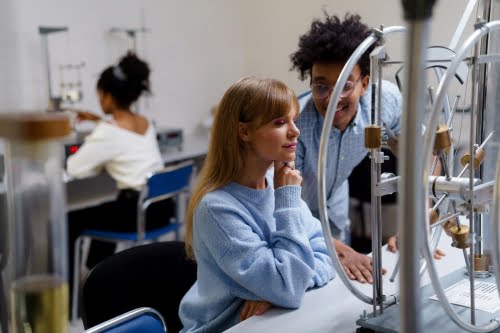Peer tutoring is a highly effective educational strategy that involves students teaching and learning from one another in a structured setting. It’s a collaborative approach where students of similar age or grade levels assist each other in understanding academic concepts, mastering skills, and achieving academic success. This method not only benefits the student receiving assistance but also enhances the tutor’s understanding of the subject matter. In this comprehensive exploration of peer tutoring, we’ll delve into its definition, benefits, implementation strategies, examples, and best practices.
Definition of Peer Tutoring
Peer tutoring can be defined as a reciprocal teaching method where students take on the role of both tutor and tutee. In this arrangement, students with stronger understanding or skills in a particular subject area provide assistance to their peers who require additional support. It’s a symbiotic relationship where both parties benefit from the learning process.
Benefits of Peer Tutoring
1. Improved Academic Performance: Peer tutoring has been shown to enhance academic achievement. When students explain concepts to their peers, it reinforces their own understanding of the material.
2. Increased Self-Confidence: Both tutors and tutees experience a boost in self-confidence. Tutors gain confidence in their ability to explain concepts, while tutees gain confidence as they grasp challenging material with the help of their peers.
3. Enhanced Communication Skills: Peer tutoring fosters the development of communication skills such as articulation, active listening, and empathy. Tutors learn to convey complex ideas in simple terms, while tutees learn to ask questions and seek clarification.
4. Promotion of Collaboration: Peer tutoring encourages collaboration and teamwork among students. It creates a supportive learning environment where students work together towards common goals.
5. Tailored Support: Peer tutoring allows for personalized assistance tailored to the individual needs of the tutee. Tutors can adapt their explanations and teaching strategies based on the tutee’s learning style and pace.
6. Cultural Sensitivity: In culturally diverse classrooms, peer tutoring can promote cultural sensitivity and understanding. Tutors and tutees from different backgrounds have the opportunity to learn from each other’s perspectives and experiences.
Implementation Strategies
1. Training and Preparation: Before engaging in peer tutoring, students should receive training on effective tutoring techniques, active listening, and providing constructive feedback. This can be done through workshops, peer mentoring programs, or online resources.
2. Pairing Students: When pairing students for peer tutoring, consider factors such as academic strengths and weaknesses, personality compatibility, and cultural background. Ideally, pairings should be mutually beneficial, with each student bringing something valuable to the partnership.
3. Establishing Clear Expectations: Set clear expectations for both tutors and tutees regarding their roles and responsibilities. Tutors should understand that their role is to facilitate learning rather than simply providing answers, while tutees should actively engage in the learning process and seek clarification when needed.
4. Monitoring and Feedback: Supervise peer tutoring sessions to ensure that they are productive and supportive. Provide feedback to both tutors and tutees on their performance, highlighting areas of strength and areas for improvement.
5. Promoting Peer Support Networks: Encourage the formation of peer support networks where students can collaborate outside of formal tutoring sessions. This can take the form of study groups, online forums, or peer-led review sessions.
Examples of Peer Tutoring
1. Math Buddies: In elementary schools, older students can serve as “math buddies” for younger students who are struggling with math concepts. The older students can help their younger peers with homework assignments, review basic skills, and provide additional practice exercises.
2. Language Exchange Programs: In language classes, students can participate in language exchange programs where they practice speaking with native speakers of the target language. This peer-to-peer interaction helps improve language proficiency and cultural understanding.
3. Writing Workshops: In high school or college writing courses, students can participate in peer writing workshops where they provide feedback on each other’s essays or creative writing assignments. This peer review process helps students improve their writing skills and learn from each other’s strengths and weaknesses.
4. STEM Mentorship Programs: In STEM (Science, Technology, Engineering, and Mathematics) fields, upperclassmen or graduate students can mentor younger students who are interested in pursuing careers in STEM. Mentors can provide guidance on coursework, research opportunities, and career pathways.
5. Cross-Age Tutoring: Cross-age tutoring programs pair students from different grade levels or age groups. For example, high school students may tutor elementary school students in reading or math. This not only benefits the younger students academically but also provides leadership opportunities for the older students.
Best Practices for Peer Tutoring
1. Encourage Active Participation: Both tutors and tutees should actively participate in the tutoring process. Tutors should ask probing questions to assess the tutee’s understanding, while tutees should engage in discussions and ask for clarification when needed.
2. Create a Positive Learning Environment: Foster a supportive and inclusive learning environment where students feel comfortable asking questions and making mistakes. Avoid criticism or negative feedback, and instead focus on constructive feedback and encouragement.
3. Monitor Progress: Regularly assess the progress of both tutors and tutees to ensure that the peer tutoring arrangement is effective. This can be done through informal check-ins, assessments of academic performance, or feedback surveys.
4. Promote Peer Relationships: Encourage students to develop positive relationships with their peers beyond the tutoring sessions. This can include activities such as icebreaker games, team-building exercises, or group projects.
5. Celebrate Achievements: Recognize and celebrate the achievements of both tutors and tutees. This can be done through certificates of appreciation, public acknowledgments, or rewards such as extra credit or privileges.
Conclusion
Peer tutoring is a powerful educational tool that benefits both tutors and tutees in numerous ways. By fostering collaboration, communication, and academic support among students, peer tutoring contributes to a positive learning environment and promotes academic success. By implementing effective strategies and best practices, educators can harness the full potential of peer tutoring to enhance student learning and achievement.











